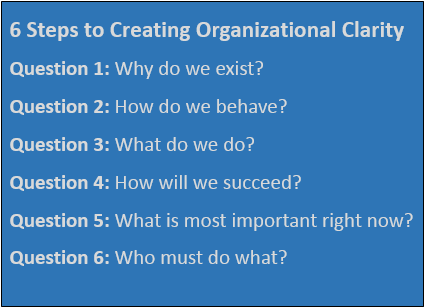Our 6 Steps to Creating Organizational Clarity at Mavidea
Here at Mavidea, we continuously explore new ideas, evaluate them and work toward making our organization more energetic, vital and truly engaged.
We host meetings of our company Culture Club to keep us on track. Recently, our group has been reading the book, The Advantage: Why Organizational Health Trumps Everything Else In Business, by Patrick M. Lencioni.
Lencioni’s organizational health model is made up of four disciplines. The one we’re focused on right now is the second discipline: Clarity. We’ve made it our cultural theme for the year.

Organizational Clarity begins by answering 6 questions:
Here is how we worked through them at Mavidea.
Question 1: Why do we exist?
We exist to have fun serving others.
Question 2: How do we behave?
We behave in a way that answers what our core values are today and also, what we hope our aspirational values will be tomorrow. We do this in order to achieve not just success, but a greater value of success.
Question 3: What do we do?
For Mavidea, this is a short, simple statement about what we do inside of our business each day to serve our customers.
Question 4: How will we succeed?
To address this question, we try to answer through the process of narrowing our business activities down to those that are essential to us as a business. We put them into the three categories mentioned in Lencioni’s book called Strategic Anchors.
Taken together, Strategic Anchors create a lens by which you see everything you do as a business. They help you see value of the work your organization does and the services it provides.
Working through this question is a good way to decide whether to make an addition to your business. It might also help us decide not to make a certain addition if we decide that this action will not help us support our culture and our purpose.
Everything we do here at Mavidea must be focused on one of those three things or all of them.
Think of it this way: You might have a million horsepower in human terms to power your business. But you have to apply this energy where it has the most effect — or you lose power. From a leadership and business planning standpoint, it makes sense to focus your greatest horsepower where it creates the most clarity.
Focusing your human power also has an impact on employee retention. Why? Because most people leave their jobs because they don’t understand where they fit or how they are making a difference.
Ultimately, we want our team to clearly understand the difference they make and where they fit.
On this point, I’m reminded of a story told by General Colin Powell about President Ronald Reagan during his time in office.
Powell was impressed with the way Reagan treated the person who cleaned his office. When Powell asked him about it, Reagan said that he wanted her to understand that the wonderful job she did was important. Also, that her effectiveness in her role made a contribution to how well he did in his own job in leading the country.
The care, attention and passion she had for bringing polish to the Oval Office actually had an impact on his own role of representing the United States as the number one country in the world.
The story brings home the importance of helping each team member take pride in his or her role and accomplishments. Individual contributions are what make an organization succeed.
Question #5: What is most important right now?
This question encourages you to focus on the one thing preventing you from reaching what you define as success. It also guides you toward building a plan and objectives to address those obstacles and making improvements that can move your organization forward.
It’s tough; because at Mavidea, like many young companies, we have a lot of things we could choose to put our attention on!
But we know that having the discipline to focus is important.
As an example, a CEO once stepped in front of his employees to give his State of the Union speech. He announced, “We’re going to succeed because we’re going to cut expenses, grow revenue, increase profits and improve customer service!”
But by saying everything is important to us, we’re also unconsciously saying nothing is important to us. This kind of thinking gives us nothing to focus on – and no clear path to address what is most critical for us to act on right now.
When you make every thing important you compromise everything.
Question #6: Who must do what?
This one’s pretty straightforward. You need to identify who’s going to do what part of the one thing you identified in Question 5. It’s a job of making assignments, making plans and setting goals and deadlines.
By narrowing the focus and bringing clarity to the one important goal, it’s possible for even a small or medium size group to move mountains in terms of making real progress toward the big goals that really move an organization forward.
Clear choices. Clear direction. Clear empowerment.
When you focus your organization on clarity, it empowers your team to address the most important job you need to do. Most importantly, it builds an understanding of why you need to do it.
It leads you to showing your team how they fit in and how they can contribute. Ultimately, your group will understand why each individual contribution is so meaningful to the rest of the team and to the future of the company.
For more about our approach to defining organizational Clarity at Mavidea, see our previous post, A Clear and Present Culture: How Leadership Clarity Creates Organizational Health for Small to Medium Sized Businesses. We’re building a Contagious Culture at Mavidea. Contact us to learn more.
